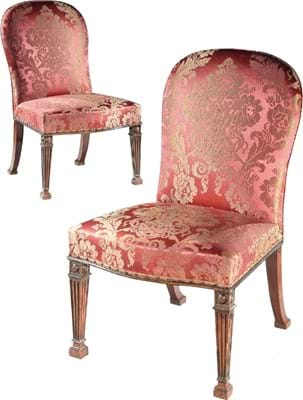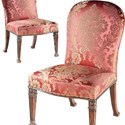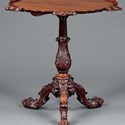It is the perhaps the greatest auction of English furniture that never was. The Dumfries House collection, handpicked by the fifth Earl of Dumfries from the Chippendale & Rannie workshop in the mid-1750s, was scheduled for sale in July 2007 at Christie’s in London.
The photography was done, the catalogue mailed and the merchandise, representing around 10% of the known fully-provenanced Chippendale furniture, carefully packed.
The story goes that the call came for the trucks to turn around and return to Ayrshire at 1am. A £45m rescue package, headed by Prince Charles, had been agreed.
Instead, the exceptional collection of early Chippendale rococo furniture at Dumfries House is at the heart of this year’s Chippendale 300 initiative, a nationwide celebration marking the tercentenary of the birth of Britain’s most famous furniture maker, designer and entrepreneur, Thomas Chippendale Senior (1718-79).
Historic houses, museums and craft organisations that own, study and work with Chippendale furniture and interiors have come together to form a programme of events, the like of which is seldom afforded a mere artisan.
It’s a rare chance to see some of the finest furniture ever made alongside the drawings, the design books, the letters and the invoices that were famously the source of so much financial strife.
Modest beginnings
In the words of Simon Phillips, owner of London dealership Ronald Phillips, “Thomas Chippendale is the only name that really means anything in English furniture”. However, on account of his modest beginnings, we know precious little about the man apart from his name.
No portrait of Chippendale survives and it is a matter of speculation what he did with his life between an elementary education at Otley Grammar School – the only child of the ‘joyner’ John Chippendale (1690-1768) and Mary (1693-1729), daughter of a stonemason – and 1748, when the certificate of a marriage to Catherine Redshaw places him in London.
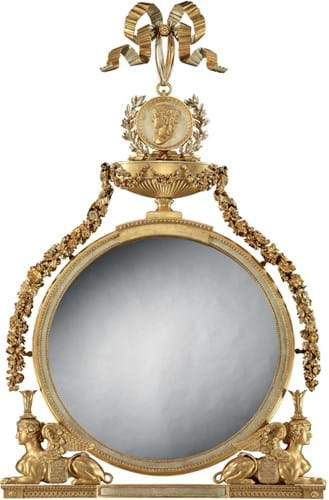
This 6ft 7in (2.01m) high circular giltwood mirror c.1785 is from a set of four made by Chippendale for the White Drawing Room at Harewood. This example was rediscovered in North America in 2016. From Ronald Phillips, London.
Most of what we know about Chippendale’s workshop in the furniture-making quarter of St Martin’s Lane comes from an insurance claim made following a fire across three buildings in 1755 (two years after it had opened). That 22 sets of woodworking tools were lost is an indication of the number of craftsmen working there.
Financial backing for the business came from the Scottish businessman James Rannie whose name appeared on company literature – as Chippendale & Rannie, Cabinet Makers and Upholsterers – until 1766.
A trading opportunity
Throughout the tercentenary year the antiques trade is not resting on its laurels. It is perhaps too much to hope for a return to the heyday of antique furniture buying, but this unprecedented focus on one aspect of the decorative arts can only be a positive.
In addition to significant contributions to events such as the exhibition running at the Leeds City Museum (until June 10) – a small-but-perfectly-formed show curated by furniture historians James Lomax and Adam Bowett – a number of leading English furniture dealers are keen that the occasion does not pass without casting some sunlight on the market.
Dealer James Rolleston, of the Rolleston gallery on Kensington Church Street, sees an opportunity to re-establish the difference between good and exceptional pieces of English furniture.
“Today, the media and auction houses often group collecting disciplines together under a very broad umbrella,” he says. “The value and appeal of a great Chippendale mahogany breakfront bookcase is not aligned to the value and appeal of a provincial Victorian bookcase and vice-versa. They cater for different tastes and budgets.”
“Tastes and budgets were something he understood”
Tastes and budgets was something that Chippendale himself understood completely.
If Georgian furniture brings to mind ’50 shades of brown’ then it shouldn’t. Some of Chippendale’s output was vividly coloured – giltwood, lacquer and japanning, marquetry insets heightened with colourful dyes and textiles were all used to striking effect – while, excelling in every style he worked in from gothic to chinoiserie, he proved expert at meeting both the demands of his clients, and changes in fashion and taste.
There’s a belief that the appreciation of this key place in 18th century design history has been lost in recent years amid the talk of ‘boring brown’ and the prevailing narrative that English period furniture falls outside the collecting zeitgeist.
As Fulham Road dealer Guy Apter puts it: “So many people are seemingly blinkered to the past.
“Rarity, provenance, craftsmanship and beauty”
If these tercentenary celebrations can spark the public’s imagination and their appreciation for great craftsmanship, then the market will inevitably benefit.”
Apter-Fredericks will offer several pieces of Chippendale style and period furniture at Masterpiece London, including a writing table reputedly supplied by Chippendale to Raynham Hall, Norfollk.
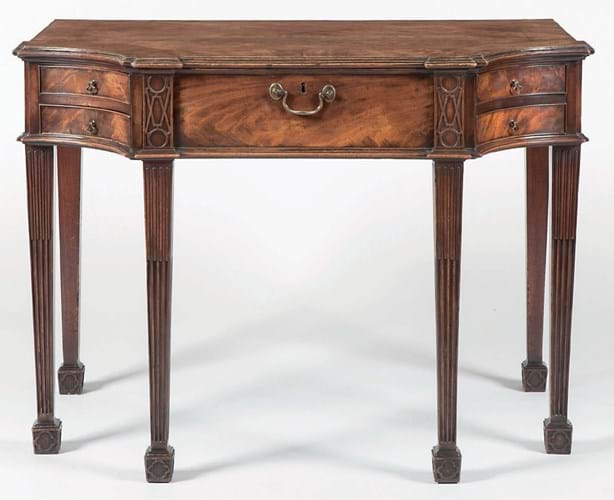
This mahogany table c.1755 is one of three known examples that (although slightly different) closely follow Chippendale’s design for a writing table illustrated in the 3rd edition of his Director. Reputedly supplied to 3rd Viscount Townshend of Raynham Hall, it was included in Thomas Chippendale, A Festival of Britain Exhibition held at Temple Newsam House, Leeds, in 1951. Apter-Fredericks will take it to 'Masterpiece'.
The price range
With only around 600 pieces traceable to his workshop – and many of those in permanent collections – fully autographed Chippendale furniture is inherently rare on the market.
Far more common are pieces ‘attributed to’ Chippendale or those ‘in the manner of’ Chippendale created in rival workshops catering to fashionable taste in London and elsewhere.
Ronald Phillips has assembled 35 pieces, each “united by the common Chippendale themes of rarity, provenance, craftsmanship and beauty” for a selling exhibition that will run concurrently at both Masterpiece London and the firm’s gallery in Bruton Street, Mayfair. “I have invested in each of these items because they have all the attributes I look for in furniture,” says owner Simon Phillips. “They are great examples of our heritage.”
Prices will range from under £10,000 for examples of the ‘off-the-peg’ furniture Chippendale produced for the casual customer or the modest functional pieces created for the running of a grand country house. Other pieces will be priced at up to £1.2m.
The Phillips show includes items from some of Chippendale’s most important commissions including Brocket Hall (1770s), the mid-1770s Etruscan-style furniture of Newby Hall and still later pieces from Home House and Aske Hall that were executed in the firm’s ‘neat but not expensive manner’.
The exhibition includes several pieces supplied to Harewood House, near Leeds, home to plantation owner Edwin Lascelles. Chippendale (whose Yorkshire roots appear to have helped in some of his largest commissions) began work at Harewood in 1767, with the family firm working there for over 30 years billing (and occasionally being paid) for over £10,000 in lavish interior decoration. The State Bed (1773) at Harewood, costing £400 for the frame, furnishings and mattresses, was the most expensive piece of furniture ever created by the Chippendale firm.
Phillips claim as a rediscovery a circular giltwood mirror supported by seated sphinxes made c.1785 to mirror the architect Robert Adam’s ceiling design for the White Drawing Room at Harewood that was demolished in the 1840s. Probably from a set of four (two were sold in 1987), this example was rediscovered in North America in 2016 and then painstakingly restored. “It doesn’t get much better than Harewood,” says Simon Phillips. “That puts the piece [priced in excess of £500,000] in a different league.”
The Dundas suite
Christie’s is holding a sale titled Thomas Chippendale: 300 Years. The auction includes two of the famous ‘Dundas’ giltwood sofas from the suite designed by Robert Adam and made by Chippendale for Sir Lawrence Dundas (the only known instance of the cabinet-maker working to another design). In all, four sofas and eight armchairs were supplied in 1765 to Dundas for the Great Room at 19 Arlington Street, London, at a cost of £410.4 shillings.
Dispersed by auction in 1934, elements of the suite have appeared on the market in recent years – at Christie’s in 1997 and again in 2008 when the record for English furniture was broken four times in a single sale. Perhaps it might not be the Dumfries House collection, but that record will again be threatened on July 5 when the Dundas sofas come up for sale with a hefty price tag of £2m-3m each.


